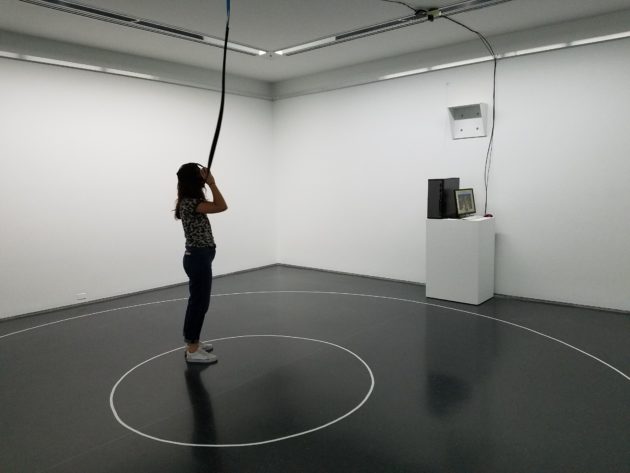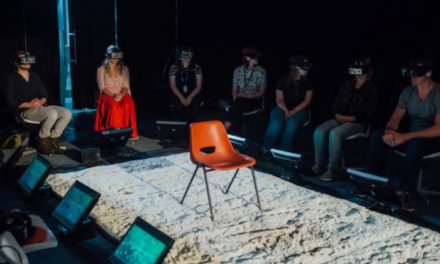The stereotypical stuffy art museum experience is a thing of the past. At least, it can be if you don’t mind using a smartphone or VR headset to enhance your eyes.
Remember what it was like to visit an art museum in the last century? Crowded Sunday afternoons, peering at paint on a wall, quietly shuffling around other patrons to read a tiny explanatory sign hanging next to a canvas. Now, museums are extending their core “content” — that is, works of art — on-site and off in ways that mix digital and physical media.
And it’s clear that no one technique for extending reality will meet every artist, art lover’s, or institution’s needs.
I went hands-on with two approaches that incorporate virtual and augmented reality into exhibitions now on view, and investigated a third from afar (my travel plans haven’t yet aligned with an in-person visit).
My juried verdict? AR/VR applications can be be startling and cool, or just museum pieces that don’t do much more than add a layer of technological lacquer to the art.

Seattle Art Museum’s “Double Exposure”
Walking into the special exhibition galleries for Seattle Art Museum’s “Double Exposure,” I was encouraged to use the museum’s free WiFi to download the Layar app. As I browsed the more than 150 images by historic photographer Edward S. Curtis, as well as more contemporary work about Native America from three other artists, I looked for the Layar icon on labels next to the images.
Launching the app to view a photograph a second time through my smartphone screen, Layar recognized the image and immediately began to play related content. For the historic Curtis images, these were video commentaries. But for Will Wilson’s contemporary tintypes, Layar animated the photographic portraits. Wilson’s subjects suddenly start to talk, sing, dance, or play music.
Rookie mistake: I didn’t bring headphones. Suddenly patrons around me were very aware that my phone’s media volume was set to full. I quickly turned it down and swore my wireless workout earbuds would come with me next time.

My take was that while the video commentaries for Curtis’ photographs could be interesting, they basically were a visual version of spoken commentaries you’d get in an old-style audio guide wand — and, unless you just listened to your phone, you were distracted into looking away from the artwork.
But the portrait animations were mesmerizing, adding a magical depth to the work on the wall. A static figure holding a violin was now playing it. A woman wearing an elaborate Native dress was suddenly dancing in it.
Tasia Endo, SAM’s manager of interpretive technology, told me after my visit that it was a balancing act to put both the commentaries and the animations in Layar. “It made sense to put the video commentary on the same platform which we have used before,” she said, “so that visitors have multiple reasons to use the app while in the exhibition.” Another balancing act? Taking into account the layout of the galleries, so there would be AR content throughout.
As to my forgetting the need for headphones? “There’s flexibility for visitors to listen to the content aloud at lower levels as long as it doesn’t disturb other visitors,” she politely said.

Museum of Contemporary Art Chicago’s “I Was Raised on the Internet”
Sometimes, extended reality isn’t a new way to explore a museum’s art works. It’s an art work in and of itself. That’s the case for two installations at Chicago Museum of Contemporary Art’s special exhibition, “I Was Raised on the Internet.”
Among nearly one hundred works, ranging from broken computer towers to social media images, sit two which are VR experiences: Transdimensional Serpent and Phantom.
In Transdimensional Serpent, I and three other visitors were placed in seats carved atop a huge, room-sized snake that was eating its tail. Museum staff fitted each of us with wired Oculus Rift VR headsets. Then we abruptly were observers of a march of fantastic creatures and landscapes that wouldn’t have looked out of place in worlds of writer J.R.R. Tolkien or artist Hieronymus Bosch.
For a bit less than five minutes, we stared at them, watched generic avatars of ourselves seated on an avatar of our snake, and basically just looked around. For me, the creepiest part wasn’t the creatures, but seeing the not-selves of ourselves.

The other VR artwork, Phantom, is viewed standing up in a large, empty circle by one person wearing one HTC Vive headset. Strapping it on, you can virtually walk around in a Southern Brazil rainforest thanks to motion capture technology and a custom ceiling grid. At first, the experience is less photographic and more, well, like a quick sketch of reality. But the longer I wore the headset, the less monochromatic it appeared, likely because my eyes and brain were adjusting to the resolution and illusion.
However, neither VR experience appeared real enough to fully immerse me, and the reason may have to do with how quickly our expectations of technology change. Daniel Steegmann Mangrané’s Phantom was created in 2014-15; Jon Rafman’s Transdimensional Serpent, in 2016.
Nina Wexelblatt, MCA curatorial assistant, said the two pieces included in the exhibition were purposely chosen to show different kinds of VR experiences. “Where the Rafman is seated and sculptural, the Steegmann is mobile and performative,” she said. “Experientially, the Rafman is somewhat linear, whereas the Steegmann is more abstract and open-ended.”
As to my observation of the outdated appearance of some of the VR, Wexelblatt said it actually may provide useful context. “If anything, the aging process opens the door for future viewers and art historians to contend with the convergence of technology and aesthetics at a particular moment in time,” she said.

San Francisco Museum of Modern Art’s “René Magritte: The Fifth Season”
Maybe the best way to understand surreality and abstraction in art is to become one with it, inside a participatory gallery at the end of a special exhibition. That’s what the well-known San Francisco-based design firm Frog (it helped shape the Apple IIc and several early Macintosh models), has done for the San Francisco Museum of Modern Art’s wide-ranging retrospective of the surrealist Rene Magritte.
Neither overlaying the art (like SAM’s AR) nor as art work inside an exhibition (like MCA Chicago’s VR), SFMOMA and Frog’s approach was to create a new kind of separate, physical gallery with elements of both AR and social VR. Think of it as augmented virtual reality.
The Magritte Interpretive Gallery features six “windows,” each adapted from actual Magritte paintings, and incorporating depth-sensing cameras and motion-tracking technology. As viewers examine the windows, their reflection may change, their image or objects may move, or a visual gateway may open into a digital reality.
While I haven’t yet visited this view of Magritte, the description and a compelling video of the interpretive gallery made me wonder — why? Is it just for fun?
“There is an educational component to the interpretative gallery, although not presented in what is perhaps a more expected, didactic form,” said Charles Yust, Frog’s principal design technologist. Yust told me the gallery, like Magritte’s work, explores identity through techniques like “obstruction” and “fragmentation.”
“We wanted visitors to take more than a selfie out of the exhibition – we hoped that they’d leave with a few questions about ‘the real and the mystery that is in the real,’” Yust said.
All told, all three approaches to extending reality demonstrate there is no one right, or even accepted, way to apply AR and VR inside art museums.

There are limits to consider. For example, not every special exhibition is suited for augmented reality overlays. SAM’s Endo said two-dimensional works are best for AR, and its “Double Exposure” is only the third recent special exhibition to use Layar, following the earlier “Kehinde Wiley” and “Seeing Nature” exhibitions.
Another is space and staff. At MCA Chicago, its virtual reality works, “are installed in decided rooms, both because of the size of the installations and also to accommodate the lines that form around the works,” Wexelblatt said. Specially trained staff also help visitors put on headsets, deal with any disorientation, and troubleshoot the technology.
Finally, there’s the matter of not messing with the artist’s vision. “We made sure to modify or abstract those paintings we were inspired by, so that we weren’t creating a collage of a painting or series of paintings,” Frog’s Yust said of the SFMOMA Magritte gallery. “That would have been disrespectful of the artist and the curator’s intent.”

But there are also unique benefits to applying digital technology. MCA Chicago has extended its exhibition with online-only artworks and has a downloadable MCA GreetAR app. SAM has created a “Double Exposure” companion site for those who missed or want to re-live Layar enhancements.
“In many ways, AR/VR can make fine art more participatory, and museum collections more available to a larger audience,” Yust said. “It is an exciting time to be a part of this space.”
BY FRANK CATALANO on
https://www.geekwire.com/2018/paint-wall-hands-vr-ar-art-museums-chicago-seattle/





